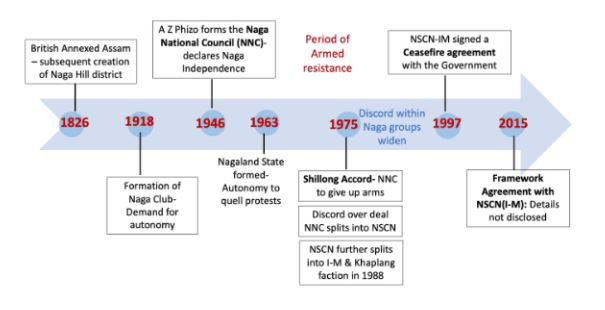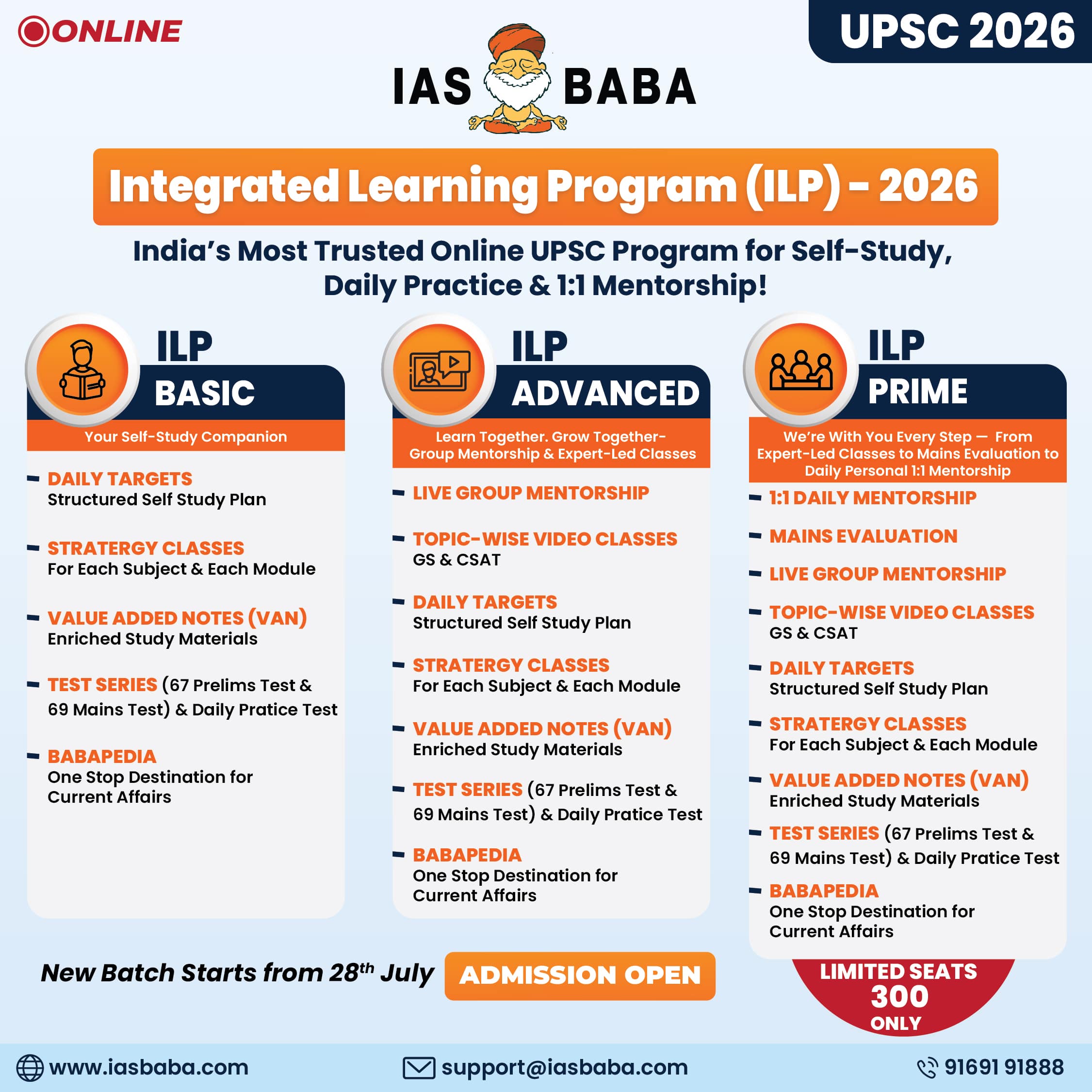The Big Picture- RSTV, UPSC Articles
Naga Peace Talks
Archives
TOPIC: General Studies 2:
- Functions and responsibilities of the Union and the States, issues and challenges pertaining to the federal structure
- North East Issues – Nagaland Issue
In News: Some “progress” is being made in coming to an understanding between the government and NSCN-IM in the latest round of informal Naga peace talks, media outlets have reported. These, however, are informal talks, and official deliberations – with the government – will follow after this round. According to media reports, officials of the Intelligence Bureau have been engaging with the NSCN-IM after relations between R N Ravi, the Centre’s interlocutor for the peace talks and also the Nagaland Governor, and leaders of NSCN-IM soured last year and the talks ended in a stalemate.
Origin of the Issue and the timeline of the events
The assertion of Naga Nationalism began during Colonial period and continued in Independent India. Below is the pictorial representation of the timeline

What are the key demands of the Naga groups?
- Greater Nagalim (sovereign statehood) i.e redrawing of boundaries to bring all Naga-inhabited areas in the Northeast under one administrative umbrella. It includes various parts of Arunachal Pradesh, Manipur, Assam and Myanmar as well.
- Naga Yezabo (Naga Constitution)
- Naga national flag.
What was the Ceasefire Agreement which was signed in 2015?
- The Government of India recognised the unique history, culture and position of the Nagas and their sentiments and aspirations. The NSCN(Isak-Muivah) also appreciated the Indian political system and governance.
- Significance: It shows the governments strong intent to resolve the long standing issue and adoption of diplomatic peaceful approach by Naga Society to fulfil their aspirations.
Reasons for not accepting Naga Demand of Separate Flag & Separate Constitution
- Regressive: Yezhabo is far less liberal than what Indian Constitution presently offers for Naga people. It is regressive and some of its provisions are against modern Constitutional values of liberty, equality & rule of law
- Challenges of Wider Acceptance: Yezhabo also proposes Naga leader Muivah as the over-arching figure of Naga politics, development and destiny which will not be acceptable to Naga Citizenry which are spread in adjoining states of Manipur, Arunachal Pradesh and Assam
- Sets a Bad Precedent: Acceding to the demand of Separate Flag will set a dangerous precedent whereby other states also demand similar provisions
- Identity Politics: Acceding to these demands is akin to giving racial and ethnic identity an equal footing with National Identity which will act as catalyst to Identity Politics in rest of India.
- Weakens National Integrity: The overall National Consciousness and National integration process will be weakened.
- Failure of Article 370: Working of Article 370 which had provided for separate Flag and Constitution has shown that such type of measures has not yielded results but has instead widened the gap between regional society and Indian mainstream.
What has happened in the years post signing the agreement?
- Enlarged Peace Talks: Talks were expanded in 2017 by including other Naga groups under the banner, the Naga National Political Groups (NNPGs)
- Bilateral to Multilateral Negotiations: The Framework Agreement envisaged a bilateral truce between two entities, but today it is seen to be a multilateral one with involvement of seven prominent Naga groups
- Deadlock in Talks Since October 2019: The deadlock was on the insistence for a separate flag and constitution by the NSCN(IM) to make way for India and Nagaland to be independent allies in a shared-sovereignty federal relationship
- Differences within Naga Groups: The NSCN (I-M) still insists on a “Greater Nagalim”. However, most of the NNPGs based in Nagaland have sought to settle the issue without disturbing the State boundaries while keeping the “Greater Nagalim” question in abeyance
What are the present grievances of NSCN-IM?
A. Interpretation of Agreement
- The agreement released by the NSCN-IM in August 2020 stated “sharing the sovereign power” and provide for an “enduring inclusive new relationship of peaceful co-existence of the two entities”.
- The NSCN-IM claims that the word ‘new’ is politically sensitive as it goes to define the meaning of peaceful co-existence of the two entities (two sovereign powers) and it strongly indicates outside the purview of the Constitution
- The position of NSCN(IM) has been “with India, not within India”.
- Conceding to this demand, especially after the abrogation of Article 370, seems improbable for the Government.
B. Grievances against Mr. Ravi (Interlocutor & also Nagaland Governor)
- The NSCN-IM has claimed that Mr. Ravi, “craftily deleted the word new from the original” to justify his own narrative and circulated to the other Naga groups including NNGPs
- NSCN-IM is also angered by Mr. Ravi’s letter to Nagaland CM, alleging the collapse of law and order and that armed gangs who question the sovereignty and integrity of the nation” were engaging in “blatant extortion”.
- This has touched a sore spot for the NSCN (I-M) as the group defended the practice by terming it “tax collection”.
- The NSCN (I-M) has demanded that Nagaland Governor R.N. Ravi should be removed as the interlocutor for talks on the Naga accord.
The Way Forward
- Any moves to alter boundaries will intensify ethnic conflicts and insurgencies beyond Nagaland.
- The Central government needs to reiterate its commitment to finalising the Naga accord while seeking to re-engage with the NSCN (I-M) without giving in to its arbitrary demands.
Do You Know?
- Nagas belong to Indo-Mongoloid Family.
- The Nagas are not a single tribe, but an ethnic community that comprises several tribes who live in the state of Nagaland and its neighbourhood. As of 2012, the state of Nagaland state officially recognises 17 Naga tribes. Prominent Naga tribes: Poumai, Sumi, Angami, Ao, Chakhesang, Chang, Khiamniungan, Konyak, Liangmai, Lotha, Pochury, Rongmei,Zeme, Mao.
- Greater Nagalim: A region carved out by integrating all Naga-inhabited contiguous areas under one administrative umbrella .It includes several districts of Assam, Arunachal and Manipur, as also a large tract of Myanmar. The map of “Greater Nagalim” has about 1,20,000sq km, while the state of Nagaland consists of 16,527 sq km .
Shillong Accord: The Shillong Accord of 1975 was an agreement signed between the Government and Nagaland’s underground government (or Naga Federal government), to accept-
- Supremacy of Constitution of India without condition
- Surrender their arms and renounce their demand for the secession of Nagaland from India
- Representatives of the underground organisations should have reasonable time to formulate other issues for discussion for final settlement.
The Nagas & the Indian Union
- In a memorandum to the Simon Commission in 1929, representatives of Naga tribes demanded that Nagas be left free after Independence and not be included in the Indian Union.
- Ahead of Independence, a nine-point agreement was signed between the Government of India and the Naga National Council which included “an experimental coexistence with India for a period of 10 years’’ to be reviewed at the end of that period.
- While the Nagas saw this provision as temporary, with a right to self-determination after 10 years, Naga historians say the Indian government has interpreted the “trial period’’ as accession to the Indian Union.
- The tallest leader of the Naga struggle, Dr A Z Phizo, met M K Gandhi in Delhi on July 19, 1947. According to Naga historians, Gandhi agreed that the Nagas would celebrate their independence a day ahead of India, on August 14, 1947.
- To this day, Nagas across Nagaland, Manipur, Assam and Arunachal Pradesh celebrate August 14 as Independence Day.
The Naga flag:
- The flag has a blue background, representing the sky. A red, yellow and green rainbow arches across the centre.
- The Star of Bethlehem adorns the top left corner of the flag; Nagas are predominantly Christian.
- The flag remains a symbol of the Nagas’ “struggle” for over 60 years, of their religious faith, of the aspirations of the Naga people, and of their identity. It helps bind all the different Naga tribes together.
Connecting the dots:
- Impact of acceding to demand of Nagalim on other States in North East.
- Article 371
- Historic Naga peace accord 2015 is like new wine in old bottle. Comment














